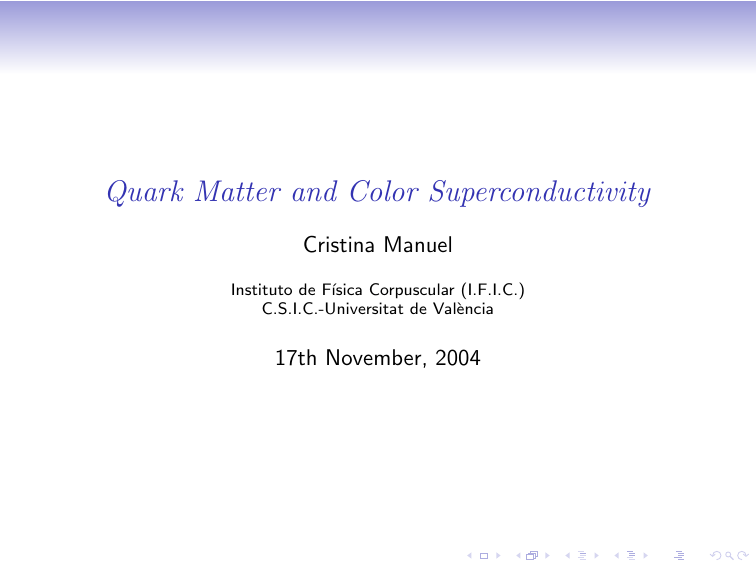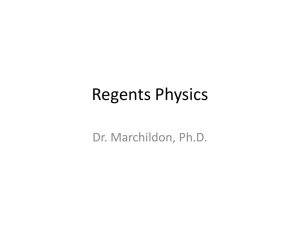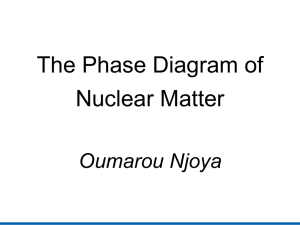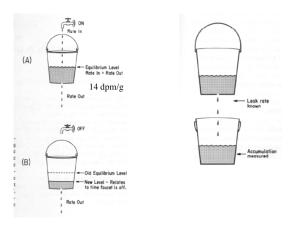Quark Matter and Color Superconductivity
advertisement

Quark Matter and Color Superconductivity Cristina Manuel Instituto de Fı́sica Corpuscular (I.F.I.C.) C.S.I.C.-Universitat de València 17th November, 2004 Motivation I The neutron is discovered in 1932. Motivation I The neutron is discovered in 1932. I Neutron stars are predicted in 1934. Motivation I The neutron is discovered in 1932. I Neutron stars are predicted in 1934. I In the last 70 years our knowledge of the structure of matter and its interactions is much deeper! Motivation I The neutron is discovered in 1932. I Neutron stars are predicted in 1934. I In the last 70 years our knowledge of the structure of matter and its interactions is much deeper! I Consequences for astrophysics?? Quantum Chromodynamics I Theory that describes succesfully the strong interactions. Quantum Chromodynamics I Theory that describes succesfully the strong interactions. I There are 6 flavors of quarks (up, down, strange, charm, bottom, top). I They carry a charge called color I Quarks come in 3 different colors: u, u, u Quantum Chromodynamics I Theory that describes succesfully the strong interactions. I There are 6 flavors of quarks (up, down, strange, charm, bottom, top). I They carry a charge called color I Quarks come in 3 different colors: u, u, u I But don’t be mislead! This is not an “optical color”. It is an internal degree of freedom, similar to e.g. spin SU(2) → SU(3) Quantum Chromodynamics I Theory that describes succesfully the strong interactions. I There are 6 flavors of quarks (up, down, strange, charm, bottom, top). I They carry a charge called color I Quarks come in 3 different colors: u, u, u I But don’t be mislead! This is not an “optical color”. It is an internal degree of freedom, similar to e.g. spin SU(2) → SU(3) I There are 8 gluons, that also carry color and are the “messengers” of the strong interactions Confinement One cannot isolate quarks and gluons: they are confined in color-neutral particles called hadrons Asymptotic Freedom Nobel Prize in Physics 2004: Gross, Wilczek and Politzer The coupling constants in a quantum field theory are not constants, but they run. Asymptotic Freedom Nobel Prize in Physics 2004: Gross, Wilczek and Politzer The coupling constants in a quantum field theory are not constants, but they run. Running coupling constants depend on the energy or scale you probe the theory. Asymptotic Freedom Nobel Prize in Physics 2004: Gross, Wilczek and Politzer The coupling constants in a quantum field theory are not constants, but they run. Running coupling constants depend on the energy or scale you probe the theory. This is a consequence from the fact that the quantum vacuum is not empty! Asymptotic Freedom This plot’s value is a Nobel Prize Spontaneous Breaking of a Symmetry Symmetry of the interactions, not shared by the ground state. Spontaneous Breaking of a Symmetry Symmetry of the interactions, not shared by the ground state. → then masless particles appear in the spectrum (Nambu-Goldstone bosons) Spontaneous Breaking of a Symmetry Symmetry of the interactions, not shared by the ground state. → then masless particles appear in the spectrum (Nambu-Goldstone bosons) In QCD, chiral symmetry in flavor space is SSB The pions, kaons and eta are the associated (quasi) massless particles. Spontaneous Breaking of a Symmetry Symmetry of the interactions, not shared by the ground state. → then masless particles appear in the spectrum (Nambu-Goldstone bosons) In QCD, chiral symmetry in flavor space is SSB The pions, kaons and eta are the associated (quasi) massless particles. Why? Let us make it dense and hot Let us make it dense and hot Then QCD is supposed to be in an deconfined phase, and asymptotic freedom tells us that in an almost free situation. Chiral symmetry is also restored. High T : situation that occurs after the Big Bang and that it is and it is going to be explored with Little Bangs I R.H.I.C. (Relativistic Heavy Ion Colliders), Brookhaven I L.H.C. (C.E.R.N.) ALICE Phase Diagram of QCD T RHIC = color superconducting QGP non−CFL gas nuclear liq compact star CFL µ Electromagnetic Superconductivity Nobel Prize in Physics in 1972: Bardeen, Cooper and Schrieffer Fermionic system at low temperature T ∼ 0 and high density, µ. Electromagnetic Superconductivity Nobel Prize in Physics in 1972: Bardeen, Cooper and Schrieffer Fermionic system at low temperature T ∼ 0 and high density, µ. Fermions ocupy all the energetic levels up to Fermi energy EF = µ. Electromagnetic Superconductivity Nobel Prize in Physics in 1972: Bardeen, Cooper and Schrieffer Fermionic system at low temperature T ∼ 0 and high density, µ. Fermions ocupy all the energetic levels up to Fermi energy EF = µ. Cooper’s theorem Any attractive interaction occurring close to the Fermi surface makes the system unstable to the formation of particle pairing Cooper pairs In this case, phonon-mediated interactions are responsible of the attractive interactions. Main properties of an electromagnetic superconductor I Appearance of an energy gap in the fermionic spectrum r p2 E= ( − µ)2 + ∆2 2m It costs energy to break the Cooper pairs. Main properties of an electromagnetic superconductor I Appearance of an energy gap in the fermionic spectrum r p2 E= ( − µ)2 + ∆2 2m It costs energy to break the Cooper pairs. I If the fermions are charged, < ψψ >6= 0, SSB of electromagnetism: the photon becomes massive. It explains the Meissner effect. Main properties of an electromagnetic superconductor I Appearance of an energy gap in the fermionic spectrum r p2 E= ( − µ)2 + ∆2 2m It costs energy to break the Cooper pairs. I If the fermions are charged, < ψψ >6= 0, SSB of electromagnetism: the photon becomes massive. It explains the Meissner effect. I Superfluid properties, transport coeffiecients ∼ exp [−∆/T ]. Color Superconductivity I It is simply the analogous of BCS theory applied to QCD. Color Superconductivity I It is simply the analogous of BCS theory applied to QCD. I QCD contains an attractive interaction: quark-quark mediated by one gluon exchange in an antisymmetric color channel. Color Superconductivity I It is simply the analogous of BCS theory applied to QCD. I QCD contains an attractive interaction: quark-quark mediated by one gluon exchange in an antisymmetric color channel. I Cooper’s theorem tells us that quarks form bound states (the Cooper pairs). I Gluons become massive. Because of asymptotic freedom of QCD one can compute all the properties of the color superconductors; µ ∼ 400 − 500 MeV , ∆ ∼ 50 − 100 MeV Richness of QCD Quarks have several quantum numbers (spin, color, flavor) They can condense in very different ways (different phases) Color-flavor Locked Phase Alford, Rajagopal and Wilczek, 98 Democratic pairing among three light quark flavors < u, s > < u, d > < d, s > < u, d > < s, u > < d, s > I Properties of this phase at long distances are very similar to those of QCD at T , µ ∼ 0 I Chiral symmetry is SSB, also baryon symmetry, and there are several Goldstone bosons. Astrophysical Consequences of Quark Matter and Color Superconductivity I Changes in the equation of state: from n, p → q. I Different cooling rates of quark stars (vs. neutron stars) I Supernova neutrinos I Magnetic fields I r-mode instability (rotational frequencies of the star) Modifications in the M/R ratio 2.5 1/4 B =180 MeV mS =200 MeV ttam 2 l. et a (z= 5) 0.3 Co M (MO·) ∆=0 nuclear (APR98) EoS 1.5 ∆=100 1 2ρo 0.5 0 6 ρ0 8 10 12 14 16 18 R (km) Quark stars (or hybrid stars) have smaller radius than conventional neutron stars. R-Mode Instabillities Anderson, 98 All relativistic rotating stars suffer instabillities above certain frequencies. r-mode oscillations grow via emission of gravitational waves, which take away energy and angular momentum, so the star would spin down. R-Mode Instabillities Anderson, 98 All relativistic rotating stars suffer instabillities above certain frequencies. r-mode oscillations grow via emission of gravitational waves, which take away energy and angular momentum, so the star would spin down. But viscosities damp these r-modes. These ideas are applied to millisecond pulsars (periods < 2.5msec.) The viscosities allow to rule out models. Madsen’s conclusions I Strange quark matter: consistent with millisecond pulsars I Color superconducting matter: inconsistent Madsen’s wrong hypothesis He assumed a behavior of the shear and bulk viscosities as in electromagnetic supercondutor ∼ exp [−∆/T ] Madsen’s wrong hypothesis He assumed a behavior of the shear and bulk viscosities as in electromagnetic supercondutor ∼ exp [−∆/T ] The story is not so simple ... Conclusion Our present understanding of the structure of matter and its interactions tells us that new types of compact stars should exist. Transport in a CFL quark star C.M, Dobado, Llanes-Estrada Cold compact stars: ) , ) . " ! Contributions of gluons, quarks and mesons are Boltzmann suppressed Goldstone boson and the in-medium photon and electron contribute Only the Shovkovy and Ellis, 02 %" ! Shear viscosity from the in medium electromagnetism ( ( ( = phonon) Effective Field Theory for the Goldstone boson of (Son, 02) It can be constructed from the knowledge of the EOS At , and for massless quarks % " ! " ! ( one can neglect both the effects of interactions and of superconductivity " ! " ! ( the phonon moves at the speed of sound Hydrodynamic Interpretation (Son, 02) The equation of motion might be re-written as a hydrodynamic conservation law " ! " ! " ! where the fluid velocity " ! Cold Relativistic Superfluid At low , phonons are excited, and they modify the hydrodynamical equations (= relativistic version of the 2 fluid model of superfluidity) Landau, Lebedev and Khalatnikov Phonons at finite : they don’t get a thermal mass, but they suffer Landau damping. ( " ! " ! " ! + and ) have the same behavior as for the phonon of superfluid He . " ! " ! (expansion is done in Damping rates at low ( + Mean free path There are collinear singularities in phonon-phonon collisions ) (associated to massless exchange; e.g. in the -channel, regulate it with diverges for small-angle collisions mean free path process (collinear) (large-angle) (small-angle) The same dependence as in superfluid He below (Maris, 73) It agrees well the experimental values, which give a power law . Shear viscosity behaves as ) Mean Free path 10000 2->2processes 1->2 processes 1 0.0001 0 0.2 0.4 0.8 0.6 1 T(MeV) km) for gure 1: It exceeds the radius of the star ( rfer superfluid then MeV: CFL would be a Conclusions ' The value of transport coefficients determine different properties of a compact star: they can be used to rule out models. ' CFL quark matter is a superfluid. At low it shares many properties of a cold superfluid He : dissipation is dominated by phonon-phonon collisions. ' Rotational properties of a CFL quark star: we still need to know whether the vortices in the superfluid cause dissipation.







